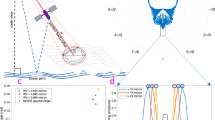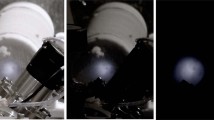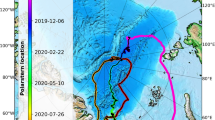Abstract
MARTIAN clouds have been classified1 into Type I, which are visible at short optical wavelengths, and become gradually invisible as the wavelength increases; and Type II, which are visible at long wavelengths, and fade into invisibility when the wavelength decreases. The three principal kinds of observed Martian clouds—yellow, white, and blue—can be categorized as Type I, blue; and Type II, yellow and white. This distinction is essential. Yellow and white clouds are classified together because they are visible in the same wavelength range; yellow clouds are dust clouds and will not be described here.
This is a preview of subscription content, access via your institution
Access options
Subscribe to this journal
Receive 51 print issues and online access
$199.00 per year
only $3.90 per issue
Buy this article
- Purchase on Springer Link
- Instant access to full article PDF
Prices may be subject to local taxes which are calculated during checkout
Similar content being viewed by others
References
Wright, W. H., Lick Obs. Bull XIII, 389, 50 (1927).
Dollfus, A., thesis, Univ. Paris (1955).
Wells, R. A., An Analysis of Martian Clouds and Their Topographical Relationships, ESRO Scientific Note 54 (1966).
Wells, R. A., Astrophys. J., 147, 1181 (1967).
Schorn, R. A., Spinrad, H., Moore, R. C., Smith, H. J., and Giver, L. P., Astrophys. J., 147, 743 (1967).
Barker, E. S., Schorn, R. A., Woszczyk, A., Tull, R. G., and Little, S. J., Science, 170, 1308 (1970).
Tull, R. G., and Barker, E. S., Ground-Based Photoelectric Measures of H2O on Mars during the Mariner 9 Encounter (Amer. Astron. Soc., Div. Planet. Sci. Conf., 1972).
Parkinson, T. D., and Hunten, D. M., Science, 175, 323 (1972).
Masursky, H., et al., Science, 175, 294 (1972).
Antoniadi, E. M., La Planète Mars (Hermann, Paris, 1930).
Herr, K. C., and Pimentel, G. C., Science, 166, 496 (1969).
Neugebauer, G., et al., Science, 166, 98 (1969).
Leighton, R. B., and Murray, B. C., Science, 153, 136 (1966).
Leovy, C. B., and Mintz, Y., J. Atmos. Sci., 26, 1167 (1969).
Hanel, R. A., et al., Science, 175, 305 (1972).
Tull, R. G., Icarus, 13, 43 (1970).
Herr, K. C., and Pimental, G. C., Science, 167, 47 (1970).
Hess, S. L., J. Atmos. Sci., 27, 1117 (1970).
Owen, T., Science, 165, 893 (1969).
Kaplan, L. D., Münch, G., and Spinrad, H., Astrophys. J., 139, 1 (1964).
Author information
Authors and Affiliations
Rights and permissions
About this article
Cite this article
WELLS, R. Mars: Are Observed White Clouds composed of H2O?. Nature 238, 324–326 (1972). https://doi.org/10.1038/238324a0
Received:
Revised:
Issue Date:
DOI: https://doi.org/10.1038/238324a0
Comments
By submitting a comment you agree to abide by our Terms and Community Guidelines. If you find something abusive or that does not comply with our terms or guidelines please flag it as inappropriate.



